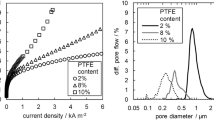Abstract
Experimental measurements are reported for a complex conducting porous electrode system consisting of electronic and ionic conducting particles. A very large value of the ionic conductivity within the electrode is its main characteristic. The complex conducting electrodes and traditional graphitic granular electrodes were used separately to recover silver from a silver plating rinse water. The former displayed excellent performance. A packed-bed reactor composed of the complex conducting electrodes has been successfully tested on a plating line.
Similar content being viewed by others
Abbreviations
- a :
-
specific interfacial area of the electrode bed
- c :
-
concentration of reactants
- c o :
-
initial concentration of reactants
- F :
-
Faraday constant
- I :
-
cell current
- i 0 :
-
exchange current density
- L :
-
thickness of electrode bed
- p :
-
electric power
- Q :
-
volume flow rate
- R :
-
universal gas constant
- r :
-
percentage recovery of silver
- s :
-
space velocity (i.e. the number of dm3 solution per dm3 volume of electrode per hour)
- S :
-
normalized space velocity (i.e. the number of dm3 solution whose concentration could be reduced tenfold per dm3 volume of electrode per hour)
- T :
-
absolute temperature
- U :
-
cell voltage
- αa :
-
transfer coefficient for anode
- αc :
-
transfer coefficient for cathode
- ε:
-
porosity or void fraction of bed
- ɛ:
-
average current efficiency
- k :
-
effective conductivity of solution
- \(\bar \eta \) :
-
intrinsic conductivity of solution
- ν:
-
square root of dimensionless exchange current
- δ:
-
effective conductivity of conducting solid matrix
References
R. E. Sioda, et al.,Chem. Engng, Feb, 21 (1983) 57–67.
R. Alkire and P. K. Ng,J. Electrochem. Soc. 121 (1974) 95–103.
J. Newman and W. Tiedemann,J. AIChE 21 (1975) 25–38.
J. A. Trainham and J. Newman,J. Electrochem. Soc. 124 (1977) 1528–39.
Y. Volkman,J. Appl. Electrochem. 8 (1978) 347–352.
G. Kreysa and C. Reynvaan,12 (1982) 241–51.
G. Kreysa,Electrochimica Acta 23 (1978) 1351–59.
‘Water Treatment for Heating Power Station’ (in Chinese), Vol. II, Irrigational-Electric Power Publishing House, Beijing, China (1976) pp. 322.
Author information
Authors and Affiliations
Rights and permissions
About this article
Cite this article
Bingkun, Y. Improvement of the performance of porous electrodes using ionic conducting particles: Application to silver recovery. J Appl Electrochem 20, 974–977 (1990). https://doi.org/10.1007/BF01019574
Received:
Revised:
Issue Date:
DOI: https://doi.org/10.1007/BF01019574




